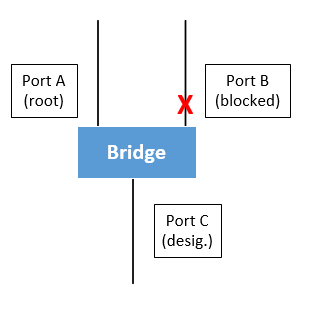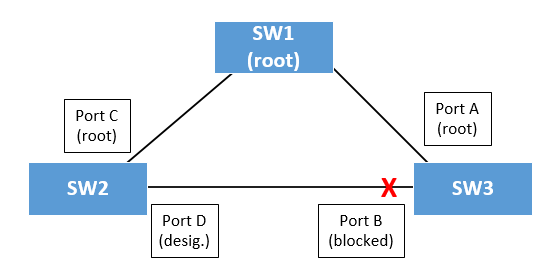STP direct vs indirect link failure
When implementing Spanning Tree Protocol (STP), a topology will become stable or "converged" when the root bridge has been selected, and all switchports have been assigned their roles. A converged topology must begin the process of reconvergence whenever there is a failure on a port or a link. This will begin what is known as a STP topology change process.
From the point of view of a switch, there are two types of link failures:
- direct
- indirect
Direct Link Failure
A direct link failure is when a switch detects a loss of carrier on its own port and immediately declares the port as disconnected. Take a look at the following figure:

The STP is converged and Port B is in blocking state. Imagine Port A goes down. The bridge no longer detects a carrier on that port and immediately causes Port B to go through the STP procedure going into the Listening and Learning states for a total of 15+15=30 seconds. Convergence time in this case is at 30 seconds.
Indirect Link Failure
An indirect link failure is when a link goes down on another switch. This is not immediately detected. Take a look at the following figure:

Ιn this figure, SW1 is the Root Bridge and Port B on SW3 is the blocked port. Also, assume SW2 has a better Bridge ID than SW3. Imagine that Port C on SW2 goes down. How will Port B on SW3 react? Let’s go through the steps.
- SW2 will no longer be receiving BPDUs from SW1 and will declare itself root bridge.
- SW2 will start advertising new BPDUs to SW3 telling SW3 that it is root bridge. SW3 will ignore them because SW1 BPDUs it’s still receiving are superior.
- SW3 will keep the information from the previously received BPDUs on Port B for 20 seconds which is the blocking timer
- Once this timer is expired, Port B will begin considering the BPDUs in the Listening state and will begin relaying SW1’s BPDUs to SW2 since they are superior
- Then SW2 will detect the better information it is receiving on Port D and will cycle the port through Listening and Learning.
- Both switches (2 and 3) will eventually place their ports in the forwarding states and connectivity will be recovered.
In this case, the total time is 20+15+15=50.
The 50 second convergence time is more often quoted for STP because it is the absolute longest time that you may have to wait for STP to fully converge.
Links
https://networklessons.com/spanning-tree/spanning-tree-reconvergence